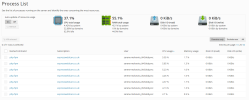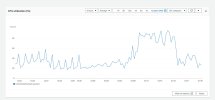- Server operating system version
- Ubuntu 22.04.3 LTS
- Plesk version and microupdate number
- 18.0.58
I have 2 websites (1 staging, 1 live) running Wordpress and Woocommerce.
1. Using Process List, I can see that there is never any disk read or write activity. Is something not configured correctly?
2. Each php-fpm process takes between 3 - 10% CPU usage. Is this normal? If not, how can I find the root cause so that I can lower the usage?

1. Using Process List, I can see that there is never any disk read or write activity. Is something not configured correctly?
2. Each php-fpm process takes between 3 - 10% CPU usage. Is this normal? If not, how can I find the root cause so that I can lower the usage?





